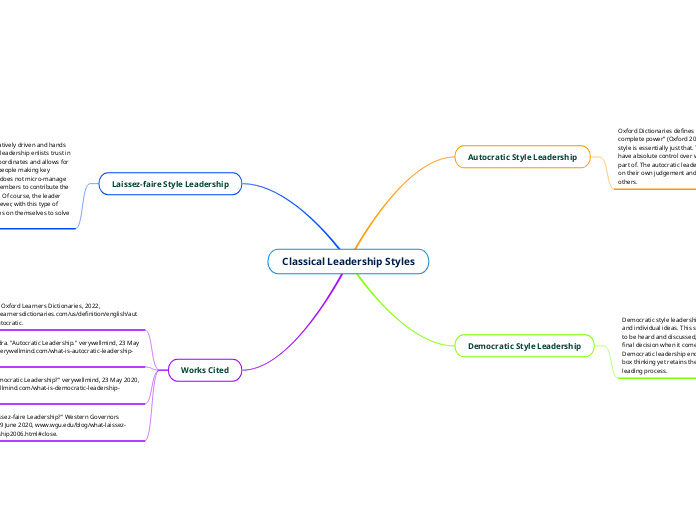
Oxford Dictionaries defines the word “autocratic” as “having complete power” (Oxford 2022), and the autocratic leadership style is essentially just that. To have autocratic leadership is to have absolute control over whatever group/business one is part of. The autocratic leader makes all crucial decisions based on their own judgement and does not allow for input from others.
Common Characteristics
Common characteristics of autocratic leadership include: no input from group members/subordinates/employees, leaders dictating work methods and decisions, a tense and uncreative work environment, clear chain of command and well-established rules.
Pros
Quick decision making
Clear chain of command
Cons
Discourages group input
Creates low morale
Ignores the possibility of better solutions to issues that arise
Democratic style leadership is the harmony between group and individual ideas. This style of leadership allows for all ideas to be heard and discussed, while having the leader make the final decision when it comes to any important matter. Democratic leadership encourages creativity and out of the box thinking yet retains the basic principles of a well-structured leading process.
Characteristics
Characteristics of a democratic leadership include collaboration among group members and their leaders, engagement between everyone involved as everyone gets a chance to share their ideas, and a high sense of creativity as innovative solutions are included in this environment.
Pros
More ideas and creative solutions being presented at a time
Everyone in the group committed to the task,
High productivity,
High sense of morale
Cons
Unskilled/under qualified groups making poor decisions
Minority opinions being overridden
Long decision-making process
Laissez-faire style leadership is a creatively driven and hands off style of management. This type of leadership enlists trust in one's employees/group members/subordinates and allows for creativity to flow freely, and multiple people making key decisions. A laissez-faire style leader does not micro-manage their team, as they trust their team members to contribute the best work they can, without their help. Of course, the leader will step in if guidance is needed, however, with this type of management an individual highly relies on themselves to solve their own problems.
Characteristics
Common characteristics of laissez-faire style leadership are little to no guidance from leaders, high amount of individual decision making, constructive criticism, leaders taking charge only when necessary, and a high sense of trust in the workplace.
Pros
An environment of trust, creativity, and reliability
A productive corporate culture
High sense of motivation
Cons
Unclear chain of command
Lack of structure and/or support from leaders
Not suited for group work (designed for individuals)
Leaders may appear uninvolved as they are not in the decision-making process.
"Autocratic." Oxford Learners Dictionaries, 2022, www.oxfordlearnersdictionaries.com/us/definition/english/autocratic?q=autocratic.
Cherry, Kendra. "Autocratic Leadership." verywellmind, 23 May 2022, www.verywellmind.com/what-is-autocratic-leadership-2795314.
"What Is Democratic Leadership?" verywellmind, 23 May 2020, www.verywellmind.com/what-is-democratic-leadership-2795315.
"What Is Laissez-faire Leadership?" Western Governors University, 29 June 2020, www.wgu.edu/blog/what-laissez-faire-leadership2006.html#close.